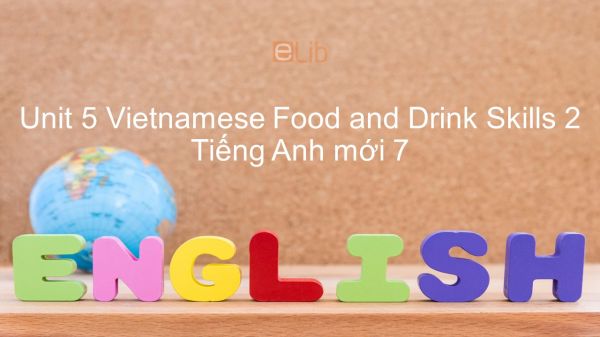Unit 5 lớp 7: Vietnamese Food and Drink - Skills 2
Bài học Unit 5 lớp 7 mới phần Skills 2 giúp các em luyện tập hai kĩ năng chính là Listening và Writing với nội dung liên quan đến các thành phần của một món ăn và các bước nấu một món ăn hoàn chỉnh. Để hiểu rõ hơn, mời các em tham khảo bài học.
Mục lục nội dung

1. Listening
1.1. Task 1 Unit 5 lớp 7
Listen to three people talking about traditional dishes where they live. Match the places with the dishes. (Nghe 3 người nói về những món ăn truyền thống ở nơi mà họ sống. Nối những nơi chốn với những món ăn cho phù hợp.)
| a. Nghe An b. Ha Noi c. Da Nang |
1. bánh tôm.................
2. súp lươn.................
3. mỳ quảng.................
Click to listen
Guide to answer
1-b. bánh tôm - Hà Nội
2-a. súp lươn - Nghệ An
3-c. mỳ quảng - Đà Nẵng
Audio script:
1.
Interviewer: Are you from Nghe An?
Man: Yes, I am.
Interviewer: Are there any traditional dishes there?
Man: Yes, there are. There’s a kind of soup. Its name is sup luon.
Interviewer: What are the ingredients?
Man: Well, there’s eel, turmeric, pepper, and some chilies. It’s often served with bread.
2.
Interviewer: Where are you from?
Woman: I'm from Da Nang.
Interviewer: Can you give me an example of a traditional dish there?
Woman: Our traditional dish is called my quang.
Interviewer: What are the ingredients?
Woman: It’s made with rice noodles, shrimp, pork,... and some vegetables.
3.
Interviewer: Are you from Hai Phong?
Man: No, I’m from Ha Noi.
Interviewer: What are the traditional dishes in Ha Noi?
Man: There are a lot. Banh tom is one.
Interviewer: Banh tom! What is it, exactly?
Man: It’s fried pastry with red shrimp on the top.
Interviewer: Mmm, sounds delicious.
Tạm dịch
1.
Người phỏng vấn: Bạn đến từ Nghệ An?
Người đàn ông: Vâng, tôi đây.
Người phỏng vấn: Có món ăn truyền thống nào không?
Người đàn ông: Vâng, có. Có một loại súp. Tên của nó là súp lươn.
Người phỏng vấn: Các thành phần là gì?
Người đàn ông: Vâng, có lươn, nghệ, tiêu và một số ớt. Nó thường được phục vụ với bánh mì.
2.
Người phỏng vấn: Bạn đến từ đâu?
Người phụ nữ: Tôi đến từ Đà Nẵng.
Người phỏng vấn: Bạn có thể cho tôi một ví dụ về một món ăn truyền thống ở đó không?
Người phụ nữ: Món ăn truyền thống của chúng tôi được gọi là mỳ Quảng.
Người phỏng vấn: Các thành phần là gì?
Người phụ nữ: Nó được làm bằng mì gạo, tôm, thịt lợn, ... và một số loại rau.
3.
Người phỏng vấn: Bạn đến từ Hải Phòng?
Người đàn ông: Không, tôi đến từ Hà Nội.
Người phỏng vấn: Các món ăn truyền thống ở Hà Nội là gì?
Người đàn ông: Có rất nhiều. Bánh tôm là một.
Người phỏng vấn: Bánh tôm! Chính xác nó là cái gì?
Người đàn ông: Đó là bánh ngọt chiên với tôm đỏ.
Người phỏng vấn: Mmm, nghe có vẻ ngon.
1.2. Task 2 Unit 5 lớp 7
Listen again. Tick the ingredients for each dish. Some ingredients are in more than one dish. (Nghe lại. Đánh dấu chọn vào thành phần cho mỗi món ăn. Vài thành phần có nhiều hơn trong một món.)
Click to listen
Guide to answer

Tạm dịch:

2. Writing
2.1. Task 3 Unit 5 lớp 7
Make notes about some popular food or drink in your neighbourhood. (Ghi chú về vài loại thức ăn hoặc thức uống phổ biến nào đó trong xóm bạn.)
Guide to answer
|
Name of the foods or drinks |
Ingredients |
How to make them |
|
Orange juice |
Orange , sugar |
Soften the orange by rolling the oranges. Cut the orange in half and remove the seeds. Grip the one of the orange halves tightly and squeeze it by hand. Add sugar into the juice and serve with ice. |
|
Fried rice |
1-2 green onions, as desired 2 large eggs 1 teaspoon salt 1 teaspoon pepper to taste 4 tablespoons oil 4 cups cold cooked rice 1 - 2 tablespoons of light soy sauce |
Beat the eggs with salt, pepper, onion. Heat the pan and add 2 tablespoons of oil. When the oil is hot, pour the mixture into the pan. When it is hot, take it out and clean out the pan. Add 2 tablespoons oil. Add the rice. Stir-fry for a few minutes, using chopsticks to break it apart. Stir in the soy sauce. When the rice is heated through, add the mixture back into the pan. Serve hot. |
Tạm dịch:
|
Tên của thức ăn hoặc thức uống |
Thành phần |
Cách làm |
|
Cam ép |
cam, đường |
Làm mềm trái cam bằng cách quay tròn quả cam. Cắt cam thành một nửa và bỏ hột. Kẹp một nửa trái cam thật chặt và vắt nó bằng tay. Thêm đường vào nước cam và uống với đá. |
|
Cơm chiên |
1 — 2 cây hành lá tùy theo ý thích 2 quả trứng lớn 1 muỗng cà phê muối, 1 muỗng cà phê tiêu để làm hương vị 4 muỗng canh dầu ăn bốn chén cơm nguội 1-2 muỗng lớn nước tương lạt |
Đánh trứng với muối, tiêu, hành lá Làm nóng chảo và thêm 2 muỗng dầu. Khi dầu nóng, đổ hỗn hợp vào chảo Khi trứng nóng, lấy nó ra và làm sạch chảo Thêm 2 muỗng dâu vào. Thêm cơm vào. Trộn trong 2 phút bằng đũa để làm rã cơm ra. Khuấy nước tương vào Khi cơm chín, bỏ hỗn hợp trứng chiên khi nãy vào chảo Ăn nóng |
2.2. Task 4 Unit 5 lớp 7
Write a paragraph about popular foods or drinks in your neighbourhood. Choose one or more. Use the information in 3, and Phong's blog, as a model. (Viết một đoạn văn về những món ăn nổi tiếng hoặc thức uống nổi tiếng trong xóm bạn. Chọn 1 hoặc nhiều món. Sử dụng phần thông tin trong phần 3, và nhật kí của Phong để làm mẫu.)
Guide to answer
FRIED RICE
We will prepare 1-2 green onions, 2 large eggs, 1 teaspoon of salt, a teaspoon of pepper, 4 tablespoons of oil, 4 cups of cold cooked rice, 1-2 tablespoons of light soy sauce.
Firstly, we beat the eggs with salt, pepper, onion. Then we heat the pan and add 2 tablespoons of oil. When the oil is hot, pour the mixture into the pan. When it is hot, take it out and clean out the pan. Next, we add 2 tablespoons oil, add the rice, stir-fry for a few minutes, using chopsticks to break it apart, stir in the soy sauce. When the rice is heated through, we add the mixture back into the pan. Remember to serve hot to have a better taste.
Tạm dịch:
CƠM CHIÊN
Chúng ta sẽ chuẩn bị: 1-2 cây hành lá, 2 quả trứng, 1 muỗng cà phê muối, 1 muỗng cà phê tiêu, 4 muỗng canh dầu ăn, 4 chén cơm nguội, 1-2 muỗng canh nước tương.
Đầu tiên, chúng ta đánh trứng với muôi, tiêu, hành lá. Sau đó chúng ta làm nóng chảo và thêm 2 muỗng canh dầu ăn. Khi dầu nóng, chúng ta đổ hỗn hợp vào chảo. Kế đến, khi trứng nóng, lấy nó ra và làm sạch chảo. Chúng ta thêm 2 muỗng dầu vào, thêm cơm vào và dùng đũa trộn trong 2 phút để làm rã cơm. Khuấy nước tương và cho vào. Khi cơm chín, bỏ hỗn hợp trứng chiên khi nãy vào chảo. Nhớ ăn nóng để có được hương vị ngon hơn.
3. Practice Task 1
Is the sentence grammatically correct? (Câu có đúng ngữ pháp không?)
Question 1: I haven't got some vegetables for dinner.
Question 2: How many bottles of mineral water are there in the fridge?
Question 3: Yesterday, I drank any cups of coffee in the office as usual.
Question 4: How much eggs do we need to make ten spring rolls?
Question 5: There is some rices left from lunch for him.
Question 6: How many flour do you need for the cake?
4. Practice Task 2
Choose the sentence with the same meaning (Chọn câu cùng nghĩa)
Question 1: Some body cleans the room every day
a. The room every day is cleaned
b. The room is every day cleaned
c. The room is cleaned every day
d. The room is cleaned by somebody every day
Question 2: They cancelled all flights because of fog.
a. All flights because of fog were cancelled.
b. All flights were cancelled because of fog.
c. All flights were because of fog cancelled.
d. All flights were cancelled by them because of fog.
Question 3: People don't use this road very often.
a. This road is not used very often
b. Not very often this road is not used
c. This road very often is not used
d. This road not very often is used
Question 4: Somebody accused me of stealing money
a. I was accused by somebody of stealing money.
b. I was accused of stealing money
c. I was accused of stealing money by somebody
d. I was accused stealing money.
Question 5: How do people learn languages?
a. How are languages learned?
b. How are languages learned by people?
c. How languages are learned?
d. Languages are learned how?
5. Conclusion
Kết thúc bài học, các em cần làm bài tập đầy đủ, luyện nghe, luyện tập viết về cách nấu một m,ón ăn phổ biến ở nơi em sống và ghi nhớ các từ vựng có trong bài:
- ingredient /ɪnˈɡriːdiənt/ nguyên liệu
- turmeric /ˈtɜːmərɪk/ củ nghệ
- chili /ˈtʃɪli/ ớt
- noodles /ˈnuːdlz/ mì sợi
- shrimp /ʃrɪmp/ tôm
- pork /pɔːk/ thịt lợn
- delicious /dɪˈlɪʃəs/ ngon
- soften /ˈsɒfn/ làm mềm
- roll /rəʊl/ lăn
- grip /ɡrɪp/ kẹp
- squeeze /skwiːz/ vắt
- beat /biːt/ đập, đánh, trộn
- stir /stɜː(r)/ khuấy, trộn
- mixture /ˈmɪkstʃə(r)/ hỗn hợp
Tham khảo thêm
- doc Unit 5 lớp 7: Vietnamese Food and Drink - Getting Started
- doc Unit 5 lớp 7: Vietnamese Food and Drink - A Closer Look 1
- doc Unit 5 lớp 7: Vietnamese Food and Drink - A Closer Look 2
- doc Unit 5 lớp 7: Vietnamese Food and Drink - Communication
- doc Unit 5 lớp 7: Vietnamese Food and Drink - Skills 1
- doc Unit 5 lớp 7: Vietnamese Food and Drink - Looking Back
- doc Unit 5 lớp 7: Vietnamese Food and Drink - Project
